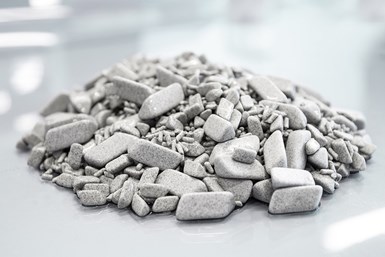Media Mix Finishes 3D Printed Plastic Components in Single Step
Because the new MJF/SLS media already contains an optimum mix of different shapes and sizes, the need for media changes in multistage finishing processes can be completely eliminated.

The new media mix from AM Solutions is said to enable the cost-efficient finishing of a wide variety of 3D printed plastic components (MJF/SLS) in one single processing step.
AM Solutions (a division of the Rösler Group) has developed a universally applicable abrasive mix that is said to provide a process-reliable and more efficient surface finish for 3D plastic parts. This new media for postprocessing of thermoplastic components is printed with the multi jet fusion (MJF) and selective laster sintering (SLS) technology.
According to the company, this media permits the safe, cost-efficient finishing of a broad spectrum of 3D printed components with different shapes and sizes in one single process step and with absolutely repeatable results. This eliminates time-consuming and costly media changes for different processing stages.
The material, shape and size of the new media has been adapted to the postprocessing requirements of 3D printed plastic components, the company says. This high versatility makes finishing processes simpler, safer and more cost-effective. The grinding performance depends on the geometrical complexity of the workpieces. For certain applications, the surface roughness can be reduced from Ra = 15 μm to Ra = 3 μm within 240 minutes.
Because the new MJF/SLS media already contains an optimum mix of different shapes and sizes, the need for media changes in multistage finishing processes can be completely eliminated. In addition, the new media type can be used for a broad range of applications, so stocking multiple media types for different work piece categories is no longer needed and represents significant cost savings.
The media is also said to help improve the stability and safety of the finishing processes thanks to a consistently high quality of the ceramic media, which is ensured through a mostly digitized and tightly controlled manufacturing process. The media also enables efficient surface grinding of extremely delicate components without causing any damage. In combination with optimized printing methods, the new media mix is said to generate highly homogeneous results for those difficult finishing tasks. At the same time, it is said to minimize scrap and saves costs.
Related Content
-
Copper, New Metal Printing Processes, Upgrades Based on Software and More from Formnext 2023: AM Radio #46
Formnext 2023 showed that additive manufacturing may be maturing, but it is certainly not stagnant. In this episode, we dive into observations around technology enhancements, new processes and materials, robots, sustainability and more trends from the show.
-
Concept Sneaker Boasts One-Piece 3D Printed TPU Construction
The Reebok x Botter Concept Sneaker Engineered by HP premiered at Paris Fashion Week, hinting at manufacturing possibilities for the future of footwear.
-
FDA-Approved Spine Implant Made with PEEK: The Cool Parts Show #63
Curiteva now manufactures these cervical spine implants using an unusual 3D printing method: fused strand deposition. Learn how the process works and why it’s a good pairing with PEEK in this episode of The Cool Parts Show.













